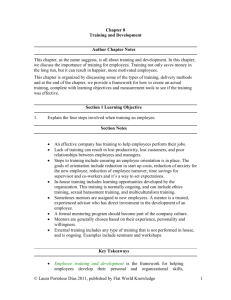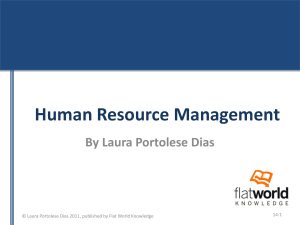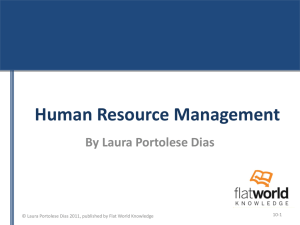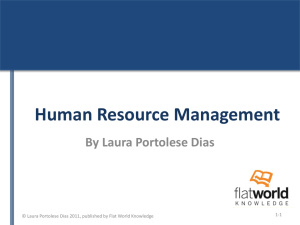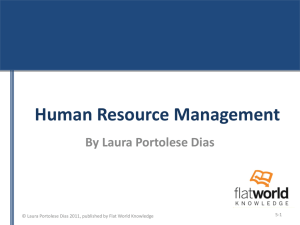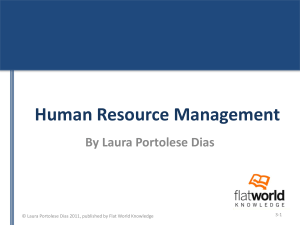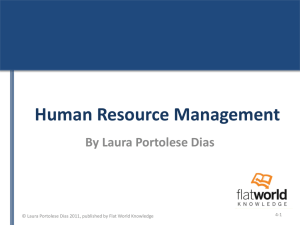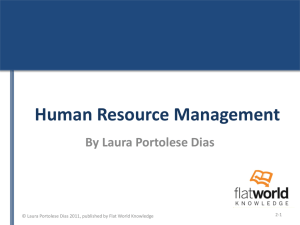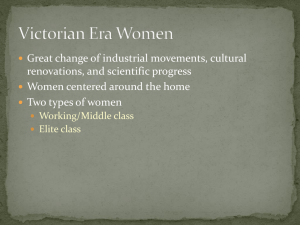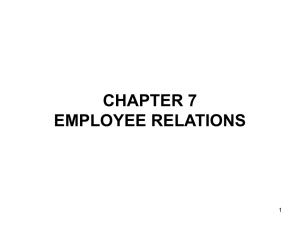Human Resource Management
advertisement
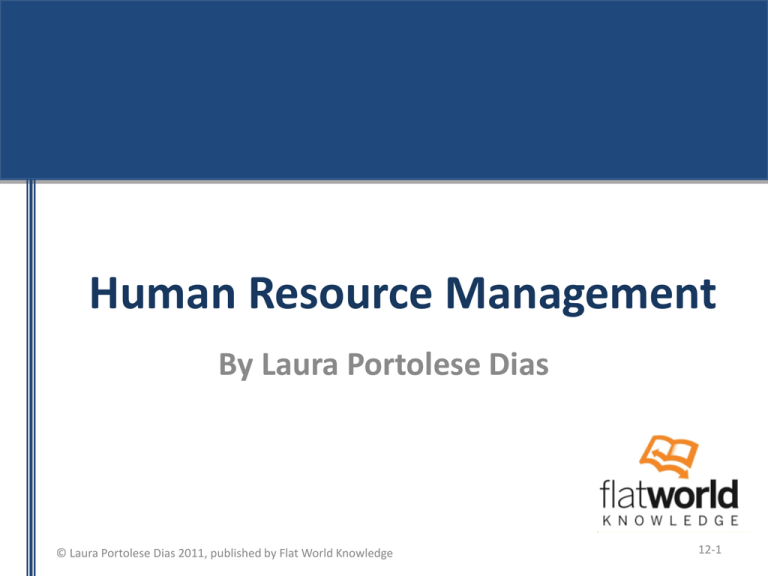
Human Resource Management By Laura Portolese Dias © Laura Portolese Dias 2011, published by Flat World Knowledge 12-1 This work is licensed under the Creative Commons Attribution-Noncommercial-Share Alike 3.0 Unported License. To view a copy of this license, visit http://creativecommons.org/licenses/by-ncsa/3.0/or send a letter to Creative Commons, 171 Second Street, Suite 300, San Francisco, California, 94105, USA © Laura Portolese Dias 2011, published by Flat World Knowledge 12-2 Chapter 12 Working with Labor Unions © Laura Portolese Dias 2011, published by Flat World Knowledge 12-3 Learning Objectives 1. Be able to discuss the history of labor unions. 2. Explain some of the reasons for a decline in union membership over the past sixty years. 3. Be able to explain the process of unionization and laws that relate to unionization. © Laura Portolese Dias 2011, published by Flat World Knowledge 12-4 The Nature of Unions • Unions – Definition – Union membership – Why do people join unions? © Laura Portolese Dias 2011, published by Flat World Knowledge 12-5 The Nature of Unions • History of Unions – NLU • Goal was an 8-hour workday – The Knights of Labor • Membership increased when NLU dissolved • Decrease in membership with unsuccessful strikes – AFL • For people wanting a change from Knights of Labor • Still in existence today © Laura Portolese Dias 2011, published by Flat World Knowledge 12-6 The Nature of Unions • History of Unions – CIO • Formed in 1930s • Merged with AFL in 1955 © Laura Portolese Dias 2011, published by Flat World Knowledge 12-7 The Nature of Unions • Main unions today – AFL-CIO • Includes Airline Pilots Association, Federation of Professional Athletes – CTW • Includes Teamsters, United Farm Workers – Independent unions • Includes Directors Guild of America, Fraternal Order of Police • Goals of national unions © Laura Portolese Dias 2011, published by Flat World Knowledge 12-8 The Nature of Unions • Union Challenges – Membership – Globalization – Company focus on nonunion status © Laura Portolese Dias 2011, published by Flat World Knowledge 12-9 The Nature of Unions • Union Laws – Railway Labor Act – Norris-LaGuardia Act – Wagner Act © Laura Portolese Dias 2011, published by Flat World Knowledge 12-10 The Nature of Unions • Union Laws – National Labor Relations Board – Taft-Hartley Act – Landrum Griffin Act © Laura Portolese Dias 2011, published by Flat World Knowledge 12-11 The Nature of Unions © Laura Portolese Dias 2011, published by Flat World Knowledge 12-12 The Nature of Unions • Strategies used to avoid unionization – Three main phases of unionization – Can use different strategies at each phase © Laura Portolese Dias 2011, published by Flat World Knowledge 12-13 Learning Objectives 1. Be able to describe the process of collective bargaining. 2. Understand the types of bargaining issues and the rights of management. 3. Discuss some strategies when working with unions. © Laura Portolese Dias 2011, published by Flat World Knowledge 12-14 Collective Bargaining • Management Rights in a Collective Bargaining Agreement • Checkoff provisions • Union Shop vs. Agency Shop © Laura Portolese Dias 2011, published by Flat World Knowledge 12-15 Collective Bargaining • Examples of bargaining topics – Mandatory topics – Permissive topics – Illegal topics © Laura Portolese Dias 2011, published by Flat World Knowledge 12-16 Collective Bargaining © Laura Portolese Dias 2011, published by Flat World Knowledge 12-17 Collective Bargaining • Bargaining Impasse results – Economic strike – Unfair labor practices strike – Lockout – Slowdown – Sickout or walkout © Laura Portolese Dias 2011, published by Flat World Knowledge 12-18 Learning Objective 1. Be able to explain how to manage the grievance process. © Laura Portolese Dias 2011, published by Flat World Knowledge 12-19 Administration of the Collective Bargaining Agreement • Collective Bargaining Agreement is ruling document for all company/employee business • Grievance procedures definition • Examples of grievances • Types of grievances © Laura Portolese Dias 2011, published by Flat World Knowledge 12-20 Administration of the Collective Bargaining Agreement • Steps in a Grievance process – Informal conversation – Union initiates grievance process – Union/management discuss – Complaint may be brought to grievance committee – Formalized response from both parties – If no agreement, national union officer – Mediation © Laura Portolese Dias 2011, published by Flat World Knowledge 12-21
